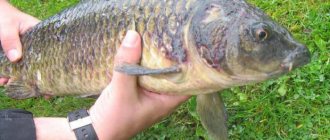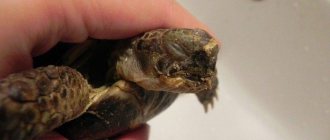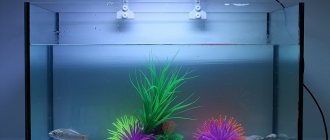Overfeeding
Some fish are capable of swallowing too large pieces of food, which creates indigestion and lingers in the stomach for up to 48 hours.
This significantly affects the appearance of the fish, so to help them, it is recommended to grind the food before serving. Bloating also occurs if the fish overeats. Due to overfeeding, they may develop abdominal dropsy or stop reproducing, because the testes and ovaries become fat. As a result, the aquarium specimen may die from such diseases.
What to do:
To avoid obesity in aquarium inhabitants, it is recommended to strictly adhere to the complementary feeding regime.
What should you do when the power goes out?
The power went out: how to save the aquarium? Alas, any aquarist sooner or later faces this question. Well, if he is experienced, then he knows what to do. What if it's a newbie? This article was written for beginner aquarists.
So, in almost any aquarium, as a rule, there are three main electrical appliances - these are: 1 - lamp 2 - filter 3 - compressor
Lamp
Light is the least of the “evils”. For several hours (and even days) without lighting in an aquarium, even in a herbalist, nothing irreparable will happen. Plants will not die, especially fish. So you don't have to worry about the light.
Filter
Now this is serious. But here, as they say, options are possible. Let's look at them. As a rule, if aquariums are up to 100 liters, internal filters are installed in them. Externals are installed in larger volumes. But in any case, the principle of saving filters is the same . Immediately before a power outage (or the night before if you are working), unplug the filter, rinse it thoroughly, cover it with a lid and leave it outside the aquarium in a cool place (not in the sun or near a radiator). The filter should be empty, that is, without water, but all substrates in it will be wet. In this form, the filter can remain “alive” for quite a long time, up to a week, and large canister external filters - up to a month and a half. If the shutdown is planned for a relatively short-term period (say, up to 6-8 hours), then wash the filter thoroughly and you can reconnect it to the aquarium (or immerse it in the aquarium, if it is an internal one). If the shutdown is long (12 hours or more), the filter must be removed/disconnected. Naturally, the above schemes are not a rigid dogma, since many factors come into play here, but in general, you need to adhere to them. If you have any doubts, it is better to ask about your specific case on the forum, making sure to indicate the lifespan of the aquarium , its capacity , and the number of fish and plants in it .
From personal experience:
We have a 320 liter aquarium in our office, which I take care of. During the 7 years of the aquarium's existence, the office moved twice. I took the fish for overexposure in my home aquariums, drained the water from the office aquarium completely, after first removing all the soil from it with a net, while simultaneously rinsing it a little from the silt. The soil was stored in plastic buckets. The filter was washed thoroughly under running water, covered with a lid, and stored in this form.
The first time the launch took place again after a month, the second time - almost a month and a half later. In both cases, both the soil and the filter, despite long periods of time, remained slightly damp (only the top layer of soil in the buckets had dried out) and “alive”, as evidenced by the characteristic smell - the living filter and soil have approximately the same smell as you will smell , being on the shore of a clean forest lake, that is, the smell of damp earth, damp grass and foliage, as if a little “mushroom”.
If you have a herbal aquarium, that is, densely planted with plants and with a small number of hydrobionts, then you can do nothing at all in such an aquarium - the filter in such a system remains clean for months, there is nothing special to wash. Even if, when the power is turned on, there is a small release of decay products (bacteria living in the filter substrate that died due to lack of oxygen), this will not in any way undermine the biosystem in such an aquarium - the grass will also say “thank you” for the additional feeding.
From personal experience:
At home I have such a herbal aquarium - it’s a hundred-liter tank, in which only 4 small fish live (three wedge bellies and one otocinclus) and several shrimps, a lot of plants. The internal filter in it is Aquael Fan-2. Once this aquarium stood “de-energized” for two days, and absolutely nothing happened to it.
Of course, it is advisable during a power outage either not to feed the fish at all, or (if these are species for which long-term fasting is contraindicated - golden ones, for example) to reduce feeding as much as possible.
Compressor
This is the most serious problem, because if you can somehow survive without a filter, then without an air supply (read oxygen) you cannot. Especially if you have a densely populated aquarium or an aquarium with large fish. Or “two in one” - densely populated with large fish. This is the most difficult case (breds and breeders are a separate conversation; we will not consider them here, since people who are seriously involved in breeding are clearly not beginners). Again, in a sparsely populated herbal garden you don’t have to worry about it - no one will suffocate there. But in other cases, either battery-powered compressors or an oxidizer will help you. So, if your region often suffers from power outages, you need to stock up on the above devices in advance.
From personal experience:
One of my home aquariums is just from the “two in one” series - densely populated with large fish. This is a capacity of 265 liters in external dimensions, minus the soil and glass - as a result, there are approximately 225-230 liters of living water maximum. And as many as 17 fish live in it - 4 clown loaches measuring from 11 to 20 cm, polypterus 20 cm, panak 13 cm, 7 geophagus 13-15 cm each, 4 old Siamese algae eaters 10-12 cm each. This is a very large load on system.
Recently I saw an announcement on the entrance door that for two days the lights would be turned off from 10 a.m. to 4 p.m., that is, twice for 6 hours.
Luckily, my filter (external Atman) was freshly washed at that time (literally on the eve of the announcement). I didn’t turn it off, I left it fixed on the aquarium. Of course, I didn’t feed the fish. But there is a problem with purging. This is where the type A oxidizer I had, for aquariums up to 400 liters, came to my rescue. And peroxide for it, of two types - 6 percent and 19 percent. I mixed them 50/50, filled the oxidizer and put them in the aquarium. And she went to work - what to do? To be honest, I was a little nervous coming back - how was it there? But everything was fine. The oxidizer coped with the task, all the fish were alive and healthy and, as soon as they saw me, they immediately began to beg for food - they were not used to starving!
In short, a power outage is an unpleasant thing, but it can be solved. Contact the forum , ask - we will help!
Author: Elena Solntseva (Pika)
Author:
August 2012
Inflammation of the gastrointestinal tract
If the fish is confirmed to have inflammation of the stomach and intestines, this indicates a lack of varied food. Symptoms of this disease in waterfowl are:
- weakness;
- darkening of the color of the fins and body;
- lethargy;
- loss of balance;
- change in excrement;
- abdominal swelling with loss of appetite.
What to do:
To prevent this disease, it is worth reducing the fish’s consumption of dry food. It is recommended to wash them, soak them, disinfect bloodworms and tubifex worms, and diversify the diet.
Aquariums without electricity - aspect No. 6. Plants, manual aeration, water exchange
Living plants, especially those living in low light conditions, can have a real impact on oxygen levels. For example, Java Moss does quite well in water tanks receiving only artificial house light and will survive almost 6 days in complete darkness.
Manual aeration is quite simple. After scooping up some water, pour it into the tank from above, which significantly increases the oxygen level.
Partial water changes will add oxygen while reducing toxin levels. Several water changes will help living things survive.
Aeromonosis, or “abdominal dropsy”
These diseases in waterfowl appear due to the entry into the aquarium of driftwood, soil, plants, snails, food, etc., infected (with viruses and bacteria), as well as due to hexamitosis.
The disease can affect any waterfowl, regardless of age and species, but the fish most often affected are: weak, old, experiencing regular stressful situations, living in poor conditions, and obese. This disease is contagious and can be transmitted to other aquarium animals through bodily wounds.
To understand that the fish has this particular diagnosis, you need to pay attention to the scales; they become like a pine cone and visually fade.
Associated symptoms:
- lethargy;
- rapid breathing;
- enlargement of the fish belly, sides, their inflammation.
What to do:
To protect your fish from disease, you need to follow the following recommendations.
Preventive measures:
- Before placing a new fish in a community aquarium, keep it in quarantine (in any other container);
- create good conditions for their habitat;
- diversify your diet and pay special attention to its correctness.
If you neglected all measures, then the sick fish needs to be transplanted from the general aquarium, and special drugs purchased at a veterinary pharmacy (pet store) should be added to the water. You can learn how to give the medicine from the instructions or from your veterinarian.
Symptoms of dropsy
For correct diagnosis, you need to know the complex of mandatory symptoms of dropsy in aquarium fish.
Exclusion of infestation by worms: with ascites, abdominal distension is strong, but uniform; when infested with worms, there may be protruding parts - where there is a cluster of worms;
Exception of pregnancy/ripe eggs : the swelling is so great that the scales of the fish rise and puff up. The top view of the fish resembles a pine cone; under the raised scales you can see whitish skin.
Additional symptoms:
- changes in the skin from loss of color to skin ulceration;
- changes in behavior, including shortness of breath (increased movement of the gills), decreased motor activity;
- the presence of mucus in the excrement - often this sign is the first and only chance for successful treatment ;
- Dropsy is often accompanied by exophthalmia, i.e. bulging eyes up to eye loss, clouding of the cornea. Exophthalmia itself is not a disease, but one of the consequences of dropsy, when fluid accumulates inside or behind. It is important to remember that exophthalmia can be a manifestation of another internal disease.
Vibrosis
This disease occurs due to infection of the fish by the bacterium Vibrio.
Most often, the disease affects individuals living in salty or slightly salty water, with a weakened immune system, as well as fish living in poor conditions. The bacterium penetrates into the home pond along with seafood complementary foods. The disease manifests itself chronically or acutely, and is expressed by the following symptoms:
- apathy;
- change in the shade of the dorsal fin;
- subcutaneous bleeding;
- rapid breathing;
- ulcers;
- desire to be alone;
- tumors;
- bloating of the abdominal cavity.
Many diseases in fish have such symptoms, so in order to clarify the correct diagnosis, you need to go to a veterinary hospital and have your pet examined.
What to do:
- When establishing this diagnosis, it will be necessary to isolate the sick fish from other cohabitants, and drip nitrofurans, antibiotics, and sulfonamides into the water for medicinal purposes. These drugs are sold in a veterinary pharmacy or store, and the daily dosage of medications can be found in the attached instructions.
- For preventive purposes, you will need: regular pet care, disinfection of complementary foods and liquids, control of chemicals in water: nitrites, nitrates, ammonia and others.
Aquariums without electricity are aspect #1. Filter care and dead bacteria
If the power supply fails, the submersible, corner and other internal filters must be removed from the aquarium. As oxygenated water passes through the filter, the waste is treated by beneficial aerobic bacteria. Ammonia is converted into less toxic nitrites and nitrates.
Stopping the flow of water causes beneficial microorganisms to die. Without aerobic bacteria, filters become a site of decomposition of organic material, which quickly poisons already stressed aquarium inhabitants.
The contents of external aquarium filters are not in direct contact with the water. These devices do not have a quick additional impact on the pollution problem. However, filters must also be disabled. When power is restored, they will begin pumping ammonia and other toxins into the reservoir.
Malawi disease
This disease affects fish from the cichlid subspecies.
Initially, “Malawi” was discovered in the inhabitants of Lake Malawi, and until now this diagnosis has not been fully studied. The disease has symptoms similar to dropsy, but is a completely different disease. Symptoms of Malawi disease:
- abdominal bloating with lack of appetite, rapid breathing with shortness of breath;
- weakness;
- lethargy.
Initially, the disease begins when the fish spends all its time on the surface of the water for several days, and after that lies on the bottom with an enlarged belly. With this disease, the pet's death occurs within 72 hours.
The disease occurs as a result of the pet living in bad water, containing sodium chloride, and an improper diet (only mammalian meat and dry food).
What to do:
- eliminate the cause of the disease;
- use experimental broad-spectrum antibiotics.
With this diagnosis, the fish die in agony, so it is recommended to euthanize them.
Why can dropsy occur in fish?
The appearance of dropsy, as a rule, is caused by a number of environmental factors, including. improperly selected composition of water in the aquarium, poor quality nutrition, lack of oxygen, age or prolonged stress can trigger the disease. The immediate cause of ascites may be:
- infection with a bacterial infection (Mycobacterium, Aeromonas, Nocardia) is most likely the source of the problem if several fish are affected at once;
- infection with a viral infection;
- the presence of protozoa in the body of the fish;
- violation of osmotic regulation (the system of maintaining water-salt balance in the body).











